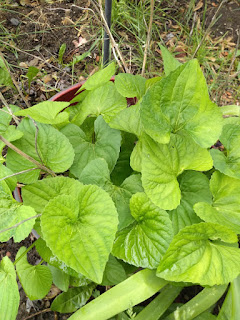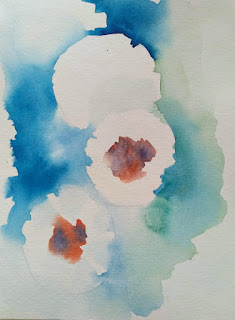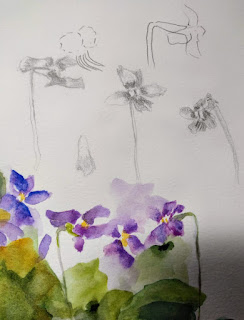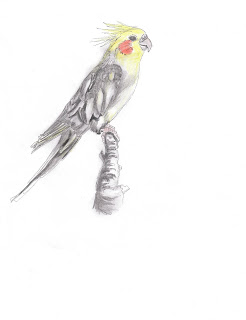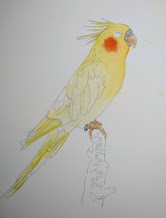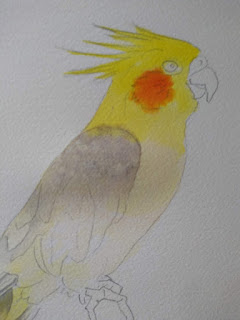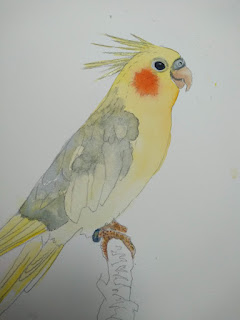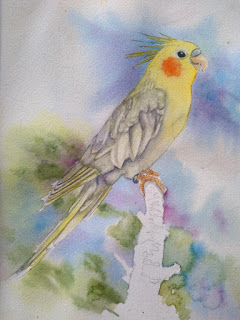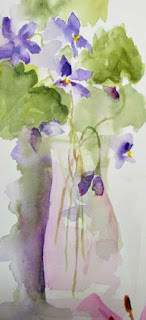
I've been checking out artists who paint much looser styles than I do, specifically: Jean Haines, Eric Yi Lin, and Liron Yankonsky, some suggested by students. I've come up with a few things they have in common, even though their styles are quite different.
First, they all suggest you need to KNOW YOUR SUBJECT before trying to paint it, either with sketches, small studies, etc.
2nd, they all agree that FAST is not necessarily good for LOOSE. Sometimes you need to take your time with an area, especially if it is going to be a focal point of the painting.
3rd, they all discuss CONNECTIONS in a painting.
4th, PRACTICE and having PATIENCE with yourself.
I really like the following youtube from Eric Yi Lin: The Real Secret of Loose Painting: Visual Language (28 min). He mentions 3 steps for better loose painting: Observe, Analyze, and Process and Interpret.
https://www.youtube.com/watch?v=NWSXVUs-B1o
Below is a 7 minute Liron Yanconsky with tips to paint loose.
For a 4-minute introduction to Jean Haines, see this youtube. Jean does not have full-length youtubes, but uses shorts to advertise her many books and videos on sale. In this one she talks about brush strokes. It will give you an idea of her current style. (She used to be a botanical painter, but developed a looser style after studying in China)
So, on with the start of this painting, ideas taken from Jean Haines book Atmospheric Flowers in Watercolor. Below is my first attempt at loose floral. I am not going to put on here any of Jean Haines' book or paintings. You can look those up online, and I don't want to infringe on her copyrights. These are my comments on some of her instructions, with some of my own results.
The NUMBER ONE THING that I've been trying to stress, first with the bird paintings and now with this one, is to KNOW YOUR SUBJECT. When flower painting, it's good to have a real flower in front of you as reference. I learned from trying this that violets are not as simple as you might think.
Below you'll see one violet that I picked from my yard, drawn from four different angles. I drew them, trying to get to know the flower, and it was enlightening how much I did NOT know.
Then I practiced painting them from different angles.
The adantage to doing this is I didn't end up with a lot of generic flower shapes that looked cookie cutter shaped.
Jean Haines suggests getting scraps of paper and doing some practices before you begin a final painting. Just small scraps. I've numbered some of her suggestions to illustrate some of my own practice. These are just painted free hand, not drawn first.
#1 is painting a violet shape just onto dry paper.
#2 is wetting the paper in flower shape first, then dropping in color and letting them blend on the paper. (I used violet and quin violet)
#3 is a little tricky. You take a flower you've painted, but is not quite dry. You wet a petal with clean water and drag some of the color over the paper to create shadow-like shapes. It gives the illusion of shadow or perhaps obscured petals.
#4 Wetting the paper (not in flower shape, just circular), allowing the paper to absorb the water a bit, then painting in petals for a very loose effect with soft edges. (This was my own suggestions, not one from Jean Haines.)
#5 Paint a green color for leaf, and while a flower petal is still slightly damp, draw the leaf color into the purple of the flower. (you can also see some of lthat on #4)
This 5th step creates what she calls CONNECTION. Every loose painter that I admire uses this principle in one way or another. It keeps your painting from looking like a lot of unconnected (even if beautifully rendered) objects.
Below is on of my practices with connecting leaves and flower petals.
The youtube by Eric Li Yin is wonderful at explaining the importance of creating connections.
You create connection in several ways, but in this case, practice allowing your colors to run together in places.
In this painting, I mostly created a flower grouping using the five practice techniques. For the stems, I painted flowy stems of light green and dropped bits of violet or quin magenta into them, varying the color a bit and creating more interest.
For the side of the vase, I just applied wet purple and dropped in some green on the left side.
Before it dried completely, I pulled some of the color into the vase (as I did with the violets). I decided it needed a little droopy flower and added that and the half flower on the right side.
My comments: I really enjoyed practicing doing these. Since I got flowers for Mothers' Day, it was a good time to practice other flowers also. It was really a matter of re-remembering some of the things I already knew and applying them in a different way.


